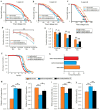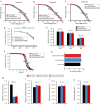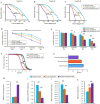Endurance exercise protects aging Drosophila from high-salt diet (HSD)-induced climbing capacity decline and lifespan decrease by enhancing antioxidant capacity
- PMID: 32414766
- PMCID: PMC7272356
- DOI: 10.1242/bio.045260
Endurance exercise protects aging Drosophila from high-salt diet (HSD)-induced climbing capacity decline and lifespan decrease by enhancing antioxidant capacity
Abstract
A high-salt diet (HSD) is a major cause of many chronic and age-related defects such as myocardial hypertrophy, locomotor impairment and mortality. Exercise training can efficiently prevent and treat many chronic and age-related diseases. However, it remains unclear whether endurance exercise can resist HSD-induced impairment of climbing capacity and longevity in aging individuals. In our study, flies were given exercise training and fed a HSD from 1-week old to 5-weeks old. Overexpression or knockdown of salt and dFOXO were built by UAS/Gal4 system. The results showed that a HSD, salt gene overexpression and dFOXO knockdown significantly reduced climbing endurance, climbing index, survival, dFOXO expression and SOD activity level, and increased malondialdehyde level in aging flies. Inversely, in a HSD aging flies, endurance exercise and dFOXO overexpression significantly increased their climbing ability, lifespan and antioxidant capacity, but they did not significantly change the salt gene expression. Overall, current results indicated that a HSD accelerated the age-related decline of climbing capacity and mortality via upregulating salt expression and inhibiting the dFOXO/SOD pathway. Increased dFOXO/SOD pathway activity played a key role in mediating endurance exercise resistance to the low salt tolerance-induced impairment of climbing capacity and longevity in aging DrosophilaThis article has an associated First Person interview with the first author of the paper.
Keywords: Aging; Climbing ability; Exercise; High-salt diet; Lifespan; dFOXO/SOD.
© 2020. Published by The Company of Biologists Ltd.
Conflict of interest statement
Competing interestsThe authors declare no competing or financial interests.
Figures








References
-
- Behrend A. M., Harding C. O., Shoemaker J. D., Matern D., Sahn D. J., Elliot D. L. and Gillingham M. B. (2012). Substrate oxidation and cardiac performance during exercise in disorders of long chain fatty acid oxidation. Mol. Genet. Metab. 105, 110-115. 10.1016/j.ymgme.2011.09.030 - DOI - PMC - PubMed
-
- Bernardi S., Toffoli B., Zennaro C., Tikellis C., Monticone S., Losurdo P., Bellini G., Thomas M. C., Fallo F., Veglio F. et al. (2012). High-salt diet increases glomerular ACE/ACE2 ratio leading to oxidative stress and kidney damage. Nephrol. Dial. Transplant. 27, 1793-1800. 10.1093/ndt/gfr600 - DOI - PubMed
-
- Blice-Baum A., Kaushik G., Viswanathan M. C., Zambon A. C., Engler A. J., Bodmer R. and Cammarato A. (2015). Overexpression of FOXO in the heart Ameliorates performance decline through enhanced UPS processing in aging Drosophila. Biophys J. 108 Suppl. 1, 361A 10.1016/j.bpj.2014.11.1979 - DOI
Publication types
MeSH terms
Substances
LinkOut - more resources
Full Text Sources
Medical
Molecular Biology Databases

